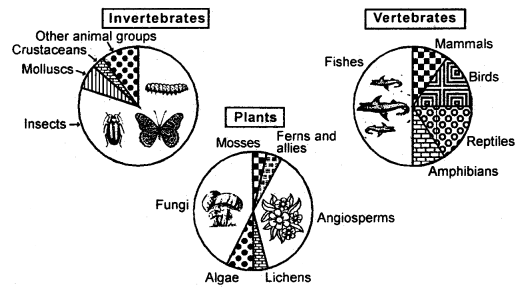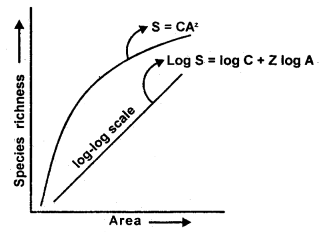By going through these CBSE Class 12 Biology Notes Chapter 15 Biodiversity and Conservation, students can recall all the concepts quickly.
Biodiversity and Conservation Notes Class 12 Biology Chapter 15
→ Biodiversity refers to the sum total of diversity that exists at all levels of biological organization.
→ Biodiversity is the term popularized by sociobiologist Edward Wilson to describe the combined diversity at all the levels of biological organization.
Some important are as follows:
- Genetic diversity
- Species diversity
- Ecological diversity
→ More than 1.5 million species have been recorded in the world, but there might still be more than 6 million species on earth waiting to be discovered and named. Of the named species >70 percent are animals of which 70 percent are insects. Among all the species, combined, the group fungi have more than all vertebrate species combined. In India, more than 45,000 species of plants and twice as many species of animals are found. Thus, it is one of the 12 mega diversity countries of the world.

Representing global biodiversity: proportional number of species of major taxa of plants. invertebrates and vertebrates
→ The diversity of plants and animals is not uniform throughout the world. For many groups of animals or plants, there are interesting patterns in diversity, the most well-known being th£ latitudinal gradient in diversity. Tropics harbor more species than temperate or polar areas. Colombia located near the equator has nearly 1,400 species of birds while New York at 41°N has 105 species and Greenland at 71°N only 56 species.
→ The relation between species richness and area for a wide variety of taxa (angiosperm plants, birds, bats, freshwater fishes) turns out to be a rectangular hyperbola (Fig.).

Showing species-area relationship on a logarithmic scale. the relationship is a straight line described by the equation.
logS = log C + Z log A
where S = species richness
A = area
Z = slope of the line
C = Y-intercept
→ Species richness contributes to the well-being of an ecosystem. Rich biodiversity is hot only essential for ecosystem health but imperative for the very survival of the human race on this planet.
→ Conserving biodiversity is narrowly utilitarian, broadly utilitarian, and ethical. Besides the direct benefits (food, fiber, firewood, pharmaceuticals, etc.) there are many indirect benefits we receive through the ecosystem. Services such as pollination, pest control, climate moderation, and flood control. It is our moral responsibility to take good care of the earth’s biodiversity and pass it on in good order to our next generation.
→ There are four major causes of biodiversity losses.
There are:
- Habitat loss and fragmentation
- Over-exploitation
- Alien species invasions
- Co-extinctions
→ Biodiversity conservation can be taken in situ and ex-situ. In in. situ conservation, the endangered species are protected in their habitat so that the entire ecosystem is protected. Ex-situ conservation methods include protective maintenance of threatened species in zoological parks and botanical gardens, in vitro fertilization, cryopreservation of gametes, and tissue culture propagation.
→ Biodiversity: Totality of genes. species and ecosystems of a region.
→ Conservation: Preservation of biodiversity. It may be in situ or ex-situ.
→ Ecological diversity: Variation of habitats, community types, and abiotic environments present in a given area.
→ Extinction: The complete disappearance of any species from the biosphere by natural causes.
→ Exotic species: Species introduced into an ecosystem to which they are not native.
→ Fragmentation: The process of reduction of habitat into smaller scattered patches.
→ Genetic diversity: Total number of genetic characteristics either expressed or in all the individuals of a particular area.
→ Species diversity: The diversity at the species level.
→ Hot spots: Areas that are extremely rich in species, and under constant threat.
→ Endemism: Species confined to that region and not found anywhere else.